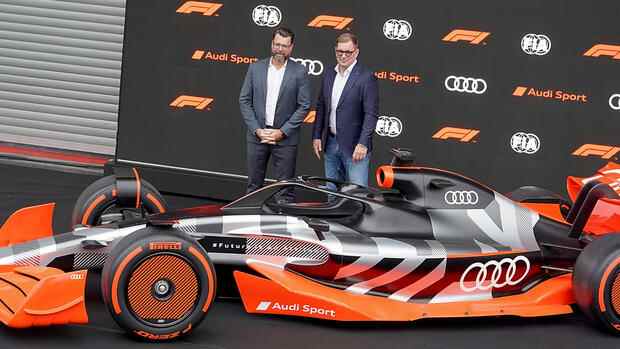Audi CEO Markus Duesmann and his Chief Technology Officer Oliver Hoffmann (from right to left): This is what an Audi car could look like with which the VW subsidiary will compete in Formula 1 in four years.
(Photo: dpa)
Dusseldorf The automotive industry is becoming greener and more environmentally friendly: At the beginning of the next decade, almost only electric cars will be sold in Europe. The entire vehicle production could then be climate-neutral and without additional CO2 pollution of the atmosphere.
Formula 1, as the most important racing class in the world, wants to demonstrate growing environmental awareness. Especially since well-known names such as Mercedes and Audi are represented or will soon be represented on the international racing scene, who see themselves as protagonists of clean (electric) drives in everyday business.
That’s why Formula 1 decided to introduce new engine regulations in the summer. From 2026 onwards, all racing teams will compete with a new mix of combustion engines and electric drives. With this hybrid approach, those responsible for Formula 1 want to guarantee that there will be no additional CO2 pollution in future races. The first car manufacturers are reacting positively to the rule change: Audi wants to enter Formula 1 in 2026.
Without CO2 on the race course
Mohammed Ben Sulayem is President of the international racing federation FIA, which organizes the Formula 1 races. With the new engine regulations, the racing class is proving that it has taken the path towards sustainability and climate neutrality. “The experience we gather in racing can later be transferred to ordinary cars in everyday use,” said the FIA President about the new regulations.
Top jobs of the day
Find the best jobs now and
be notified by email.
The future engine specifications for Formula 1 should ensure environmentally friendly racing operations from 2026 onwards in two places. Only e-fuels made from recycled materials (biomass, waste) are used in the combustion part of the hybrid drive.
In addition, an electric motor is prescribed as the second unit, which is about as powerful as the combustion engine. The future Formula 1 cars will also come with the combined hybrid drive to the current output of around 1000 hp.
An agreement with the Austrian racing team Red Bull fell through at the last moment.
(Photo: IMAGO/Motorsport Images)
When developing e-fuels, Formula 1 works closely with the Saudi oil multinational Aramco, which has been supporting motorsport for some time. According to information from association circles, Aramco will build two factories in which the e-fuels for Formula 1 will be produced.
In 2013, each racing car used an average of 160 kilograms of fuel from start to finish during a Formula 1 Grand Prix. In 2020, with stricter environmental regulations, this has already grown to 100 kilograms. With the new engine regulations, the limit would be 70 kilograms per race and vehicle.
Audi is coming because of the new regulations
It is now clear that Formula 1 was able to win the first additional car manufacturer for the racing circuit with the future engine rules. “With the adoption of the new regulations, our essential requirements for entry have been met,” said Audi CEO Markus Duesmann, explaining the entry into Formula 1. The racing series is thus taking “a big step towards sustainability”.
In 2026, the Volkswagen subsidiary wants to be on the racetrack with its own car for the first time. Audi cooperates with Team Sauber and acquires a stake in the Swiss racing team. The focus of Audi’s own development work is on the drive. Not every Formula 1 team makes its own engine.
Vettel criticizes the late timing for new regulations.
(Photo: dpa)
The Ingolstadt-based premium manufacturer is silent on the investment requirements for its own Formula 1 commitment. A mid three-digit million amount is considered the minimum stake in racing circles. Audi hopes that the effort will pay off. If the VW subsidiary were to be at the forefront of Formula 1 in a few years, there would be high advertising revenues.
With Porsche, there was almost a second new German Formula 1 competitor. But the agreement with the Austrian racing team Red Bull, which was considered safe, fell through at the last moment. The new regulations were also one of the main reasons for Porsche’s planned entry into the top class of racing.
>> Read here, why talks between Porsche and Red Bull failed
Despite efforts to be more sustainable and climate neutral, Formula 1 has come under criticism. For the former world champion Sebastian Vettel, who ends his active Formula 1 career this year, the new engine regulations would have to be introduced earlier. “I think 2026 is too late to see it as a pioneer. Synthetic fuels already exist, so why wait another four years?” said Vettel in an interview with “Spiegel”.
With the hybrid drive, Formula 1 only solves a small part of its CO2 problem. Only about one percent of the total carbon dioxide pollution occurs during the races. Much more important are the many trips around the world from venue to venue with the heavy equipment of all racing teams. Formula 1 logistics account for more than 40 percent of CO2 emissions during a racing season. By 2030, Formula 1 also wants to significantly reduce this CO2 pollution.
More: Audi and Porsche want to get into Formula 1 – but not too quickly
